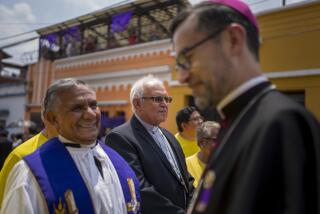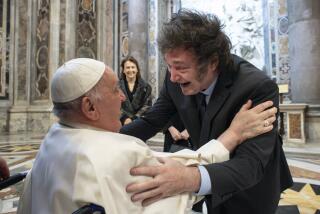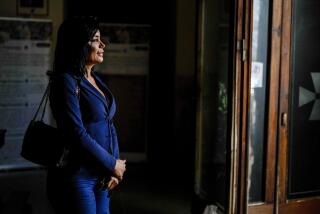Pontiff Helps to Feed Poorest of India’s Poor
- Share via
CALCUTTA — In an emotional encounter Monday with some of the most wretched people he has ever seen, Pope John Paul II helped to feed the patients at Mother Teresa’s Home for the Dying and Destitute, where her care for the hopeless of India earned her the Nobel Peace Prize in 1979.
The pontiff was driven to Mother Teresa’s hospice, in one of the most poverty-ridden quarters of the city, after arriving in Calcutta. He waved to tens of thousands of mainly Hindu greeters, who lined the route of his motorcade from the airport.
Cheerful Visit to Dying
In contrast to the subdued welcome that he received in New Delhi over the weekend, and despite the fact that most of Mother Teresa’s non-Christian patients did not have the slightest idea of who he was, John Paul’s visit was a cheerful one, even in the house of the dying.
“He must be a great person, but I don’t know what his job is,” a chronic tuberculosis victim said.
Another patient, suffering from leprosy, said, “I don’t know who he is, but he must be the big boss.”
Mother Teresa said, “He is coming to the poorest of the poor, like Jesus.”
Four of the home’s 89 patients died in the 18-hour period before the Pope’s arrival, and a fifth appeared to be on the verge of death.
‘Children of God’
“We help them to die with love and dignity, as children of God,” said the frail, 76-year-old Albanian nun, who established the hospice in 1952 and won church recognition for the religious order she founded, the Missionaries of Charity.
Viewing the bodies of the four victims in the hospice’s tiny mortuary, John Paul made the sign of the Cross on each forehead, including that of a young boy who had the Christian symbol of the Cross tattooed on his body. Then, the Pope sprinkled holy water on the bodies from a vial provided by Mother Teresa.
As he toured the men’s and women’s wards of the hospice, the Pope touched each patient. When the nuns began serving the evening meal, he took plates to half a dozen of the women and 10 of the men and helped one feeble man by spooning omelet and yogurt into his mouth.
Vatican spokesman Joaquin Navarro Valls, who was at the Pope’s side, said: “He was very, very moved. I never saw him cry, but sometimes when Mother Teresa asked him a question, he couldn’t answer.”
Some of the patients knelt to touch his feet, then kissed their hands that had been in contact with him, although he tried to discourage this. One woman cried out as he passed her bed.
“What is she saying?” the Pope asked Mother Teresa.
“She is saying that she is very, very alone and telling you to come back,” Mother Teresa replied.
‘Happiest Day of My Life’
The nun said later: “This is the happiest day of my life. I’ve been wanting this for very long.”
She said that on Monday she admitted patient No. 49685, and that about two-thirds of all those admitted have survived. For the most part, they are without homes, relatives or hope, and the nuns try to help them establish a better life, if they get well, or to plan suitable funeral arrangements if they do not.
“This is very basic nursing care--a good bed, decent food and nothing more extra, but it works,” said Clare Blyth Vickers, 23, a British volunteer nurse at the hospice.
Vickers and a friend, nurse Anne Macklow-Smith, also 23, said that despite the focus of world attention on Mother Teresa, facilities at the hospice remain limited.
Hospice Lacks Equipment
“There is hardly any equipment, and we have to improvise,” Macklow-Smith said. “It probably would have been better if we had been trained as nurses 40 years ago.”
Emerging from the shelter, donated by the adjacent Hindu temple of Kali--the presiding Hindu goddess of Calcutta--the Pope and Mother Teresa mounted a flower-decked podium to pray for those inside.
John Paul called Mother Teresa’s hospice a “place of suffering, a house familiar with anguish and pain, a house for the destitute and dying.”
‘Place of Hope’
“But at the same time, it is a place of hope, a house built on courage and faith, a home where love reigns, a home filled with love,” he said.
On the third day of his 10-day visit to India, his 29th papal tour abroad, the pontiff flew from New Delhi to Ranchi, the heart of a tribal area northwest of Calcutta, and conducted an outdoor Mass at the airport for about 300,000 people before visiting Mother Teresa.
Many of those at the Mass were from Catholic families converted in the last 60 to 80 years. People of the lowest caste, known as untouchables, have made ready converts for both Protestant and Catholic missionaries. Discrimination against untouchables was outlawed in 1955.
More to Read
Sign up for Essential California
The most important California stories and recommendations in your inbox every morning.
You may occasionally receive promotional content from the Los Angeles Times.










